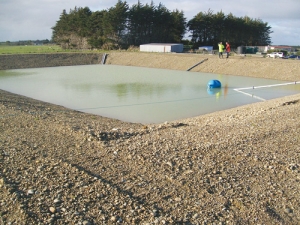Rewarding farmers who embrace sustainability
Winners of DairyNZ’s Sustainability and Stewardship awards in the Ballance Farm Environment Awards have their eyes firmly fixed on progressing a positive future for New Zealand dairy.
 A site investigation before design and construction is important to ensure the pond built is structurally sound and meets regulations.
A site investigation before design and construction is important to ensure the pond built is structurally sound and meets regulations.
A site investigation before design and construction is important to ensure the pond built is structurally sound and meets regulations, says DairyNZ.
While an engineer will probably do the site investigation, the responsibility for proving the adequacy of a pond and liner rests with the farmer.
The soil type where the effluent pond will be located is also important.
In comparison to most other soil types, peat soils require more ground investigation. The main issues are peat thickness, strength, compressibility and groundwater level.
Before ground investigations begin, a desktop study should be done by your designer, who should then explore the site. There should be a minimum of three holes around the perimeter of the proposed tank or pond. The investigation should extend to the full depth of the peat, or to twice the width of the proposed tank or pond bank.
Your designer should then perform specific engineering tests to determine the suitability of the site and the design requirements.
During the investigation and design stage make sure you discuss with the designer the cost versus benefit of different design options for peat versus the long term maintenance costs of each.
Effluent systems can include a solids separation component. This can be either mechanical (press type systems) or non-mechanical (weeping wall type systems).
If solids are removed prior to the effluent reaching the storage pond, this averts or at least reduces the risks inherent in managing the solids in the pond. But you still must store and manage them. Mechanical removal should usually be done before effluent enters the storage pond.
Non-mechanical separation methods are generally weeping wall or settling pond systems. These fundamentally change the pond design requirements. In this case the pond component of the solids removal system needs to be designed specifically for solids removal.
New Zealand dairy processors are welcoming the Government’s commitment to continuing to push for Canada to honour its trade commitments.
An educational programme, set up by Beef + Land New Zealand, to connect farmers virtually with primary and intermediate school students has reported the successful completion of its second year.
The Food and Agriculture Organisation of the United Nations (FAO) has welcomed a resolution adopted by the United Nations (UN) General Assembly to declare 2026 International Year of the Woman Farmer.
Waikato herd health veterinarian Katrina Roberts is the 2024 Fonterra Dairy Woman of the Year.
Trade Minister Todd McClay says New Zealand has no intention of backing down in a trade dispute with Canada over dairy products.
Horticulture NZ chief executive Nadine Tunley will step down in August.
OPINION: Canterbury milk processor Synlait is showing no sign of bouncing back from its financial doldrums.
OPINION: It seems every bugger in this country can get an award these days.